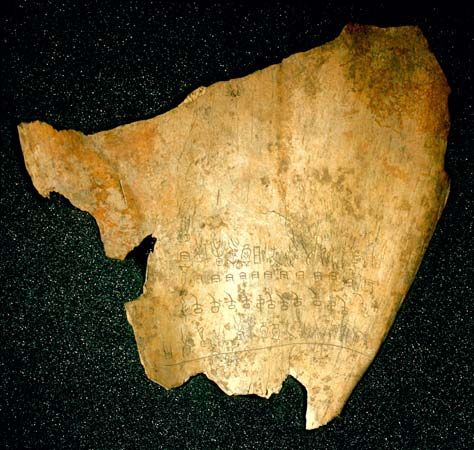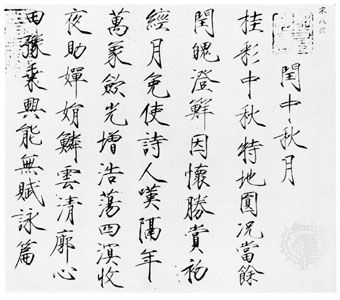Chinese writing
Chinese writing, basically logographic writing system, one of the world’s great writing systems.
Like Semitic writing in the West, Chinese script was fundamental to the writing systems in the East. Until relatively recently, Chinese writing was more widely in use than alphabetic writing systems, and until the 18th century more than half of the world’s books were written in Chinese, including works of speculative thought, historical writings of a kind, and novels, along with writings on government and law.
History
It is not known when Chinese writing originated, but it apparently began to develop in the early 2nd millennium bc. The earliest known inscriptions, each of which contains between 10 and 60 characters incised on pieces of bone and tortoiseshell that were used for oracular divination, date from the Shang (or Yin) dynasty (18th–12th century bc), but, by then it was already a highly developed system, essentially similar to its present form. By 1400 bc the script included some 2,500 to 3,000 characters, most of which can be read to this day. Later stages in the development of Chinese writing include the guwen (“ancient figures”) found in inscriptions from the late Shang dynasty (c. 1123 bc) and the early years of the Zhou dynasty that followed. The major script of the Zhou dynasty, which ruled from 1046 to 256 bc, was the dazhuan (“great seal”), also called the Zhou wen (“Zhou script”). By the end of the Zhou dynasty the dazhuan had degenerated to some extent.
The script was fixed in its present form during the Qin period (221–207 bc). The earliest graphs were schematic pictures of what they represented; the graph for man resembled a standing figure, that for woman depicted a kneeling figure.
Because basic characters or graphs were “motivated”—that is, the graph was made to resemble the object it represented—it was once thought that Chinese writing is ideographic, representing ideas rather than the structures of a language. It is now recognized that the system represents the Chinese language by means of a logographic script. Each graph or character corresponds to one meaningful unit of the language, not directly to a unit of thought.

Although it was possible to make up simple signs to represent common objects, many words were not readily picturable. To represent such words the phonographic principle was adopted. A graph that pictured some object was borrowed to write a different word that happened to sound similar. With this invention the Chinese approached the form of writing invented by the Sumerians. However, because of the enormous number of Chinese words that sound the same, to have carried through the phonographic principle would have resulted in a writing system in which many of the words could be read in more than one way. That is, a written character would be extremely ambiguous.
The solution to the problem of character ambiguity, adopted about 213 bc (during the reign of the first Qin emperor, Shihuangdi), was to distinguish two words having the same sound and represented by the same graph by adding another graph to give a clue to the meaning of the particular word intended. Such complex graphs or characters consist of two parts, one part suggesting the sound, the other part the meaning. The system was then standardized so as to approach the ideal of one distinctive graph representing each morpheme, or unit of meaning, in the language. The limitation is that a language that has thousands of morphemes would require thousands of characters, and, as the characters are formed from simple lines in various orientations and arrangements, they came to possess great complexity.
Not only did the principle of the script change with time, so too did the form of the graphs. The earliest writing consisted of carved inscriptions. Before the beginning of the Christian Era the script came to be written with brush and ink on paper. The result was that the shapes of the graphs lost their pictorial, “motivated” quality. The brushwork allowed a great deal of scope for aesthetic considerations.
The relation between the written Chinese language and its oral form is very different from the analogous relation between written and spoken English. In Chinese many different words are expressed by the identical sound pattern—188 different words are expressed by the syllable /yi/—while each of those words is expressed by a distinctive visual pattern. A piece of written text read orally is often quite incomprehensible to a listener because of the large number of homophones. In conversation, literate Chinese speakers frequently draw characters in the air to distinguish between homophones. Written text, on the other hand, is completely unambiguous. In English, by contrast, writing is often thought of as a reflection, albeit imperfect, of speech.
To make the script easier to read, a system of transcribing Chinese into the Roman alphabet was adopted in 1958. The system was not intended to replace the logographic script but to indicate the sounds of graphs in dictionaries and to supplement graphs on such things as road signs and posters. A second reform simplified the characters by reducing the number of strokes used in writing them. Simplification, however, tends to make the characters more similar in appearance; thus they are more easily confused and the value of the reform is limited.

















